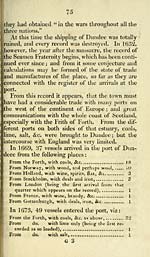Towns > Dundee > 1822 - Dundee delineated; or, A history and description of that town, its institutions, manufactures and commerce
(80)
Download files
Complete book:
Individual page:
Thumbnail gallery: Grid view | List view

74
parts of the coast in a friendly, or rather, what it
more probable, in a hostile manner, — as all voyages
of antiquity seem to have been undertaken for plun
der or conquest.
Of the early shipping of the town — of its increase
or casual diminution — of the extent of the trade it-i
self which was carried on, there is no record ; but
the river and bar must have been well known in
1 190, when the Earl of Huntingdon took refuge in
the place. Long before this, the Tay must have
been passed in some kind of boats ; though abso-
lute reliance must not be placed on the accounts
given of the passage of Catanach, whether to escape
the pursuit of Agricola, or to recruit his forces by
the assistance of Galgacus.
After a long period of years, during which either
the shipping was not recorded, or the record was
lost in the general disasters, it appears that in 1569
in the regency of the Earl of Murray, the Magis
trates of Dundee were ordered to send three ves
sels to join the fleet appointed to pursue Bothwell
who had turned pirate in the north sea, after being
obliged to leave Scotland on the surrender of Queen
Mary at Carberry Hill. The vessels sent from
Dundee formed the principal part of the fleet.
During the next century, the naval establishment
of Dundee seems to have been on the increase ;
and in 1651, when the town was ransacked by
Monk, as mentioned before, the vessels are said to
have amounted to one hundred; of which sixty \
richly laden were captured in the harbour, and af-
forded a booty in plate and money, to the storming
forces of Cromwell, exceeding the whole plunder
parts of the coast in a friendly, or rather, what it
more probable, in a hostile manner, — as all voyages
of antiquity seem to have been undertaken for plun
der or conquest.
Of the early shipping of the town — of its increase
or casual diminution — of the extent of the trade it-i
self which was carried on, there is no record ; but
the river and bar must have been well known in
1 190, when the Earl of Huntingdon took refuge in
the place. Long before this, the Tay must have
been passed in some kind of boats ; though abso-
lute reliance must not be placed on the accounts
given of the passage of Catanach, whether to escape
the pursuit of Agricola, or to recruit his forces by
the assistance of Galgacus.
After a long period of years, during which either
the shipping was not recorded, or the record was
lost in the general disasters, it appears that in 1569
in the regency of the Earl of Murray, the Magis
trates of Dundee were ordered to send three ves
sels to join the fleet appointed to pursue Bothwell
who had turned pirate in the north sea, after being
obliged to leave Scotland on the surrender of Queen
Mary at Carberry Hill. The vessels sent from
Dundee formed the principal part of the fleet.
During the next century, the naval establishment
of Dundee seems to have been on the increase ;
and in 1651, when the town was ransacked by
Monk, as mentioned before, the vessels are said to
have amounted to one hundred; of which sixty \
richly laden were captured in the harbour, and af-
forded a booty in plate and money, to the storming
forces of Cromwell, exceeding the whole plunder
Set display mode to: Large image | Transcription
Images and transcriptions on this page, including medium image downloads, may be used under the Creative Commons Attribution 4.0 International Licence unless otherwise stated. ![]()
| Scottish Post Office Directories > Towns > Dundee > Dundee delineated; or, A history and description of that town, its institutions, manufactures and commerce > (80) |
|---|
| Permanent URL | https://digital.nls.uk/85824991 |
|---|
| Description | Directories of individual Scottish towns and their suburbs. |
|---|
| Description | Around 700 Scottish directories published annually by the Post Office or private publishers between 1773 and 1911. Most of Scotland covered, with a focus on Edinburgh, Glasgow, Dundee and Aberdeen. Most volumes include a general directory (A-Z by surname), street directory (A-Z by street) and trade directory (A-Z by trade). |
|---|


